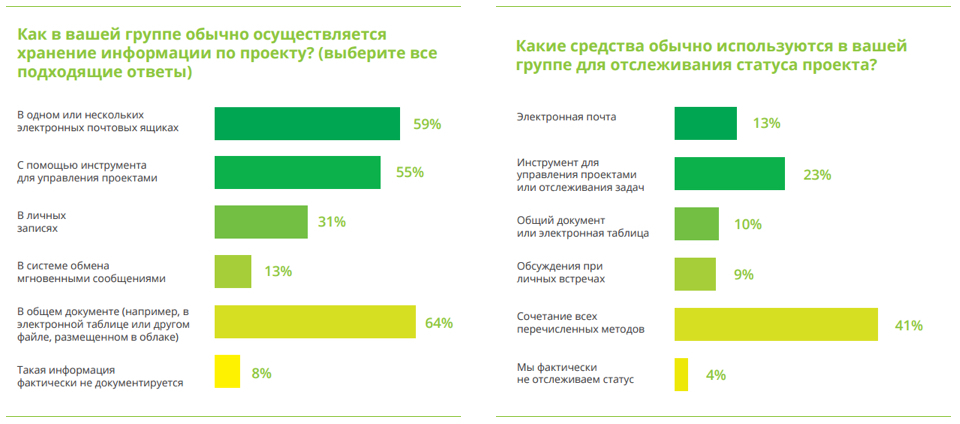Survey Wrike: What are employees dissatisfied with? Basically working with each other
As we mentioned in the previous post, Wrike conducted a large-scale survey of more than 1,400 people. Among them are managers and employees from various departments, from accounting to marketing and IT. Respondents were asked what they considered to be the main stressors and obstacles to productive work. The main goal of the survey is to make sure that we are developing Wrike in the required direction.
However, the results may be of interest to a wider circle of readers: those who manage people and set tasks in companies (to understand what is worth working on), and those who work on these tasks (at least to know that they are not alone in their discontent).
Because the findings of the survey are not the most comforting.
')

In most companies, teamwork remains far from ideal. Do not save yet and services for organizing collaboration. Even where they are, they are often used in insufficient quantities, and, as a result, they do not particularly simplify life in the workplace.
Squeak interaction
The fact that there is a massive problem with communication is eloquently indicated by the answers to the question: what causes people the greatest level of stress in a company? The results on the graph below, and they are depressing.

It is clear that the work is not a circus to please everyone, but they are headed by a list of factors that can be eliminated just by establishing normal communication in a team. Moreover, the harm from lack of interaction is not limited to employee spending on antidepressants and, of course, negatively affects key business metrics.
In addition to the reasons for stress, we asked the employees what prevents them from working productively - and here, too, a lot rests on working with people. Well, what else, if their own work 86% rated as productive. Among the interfering moments are parallel work on too many tasks (60%), waiting for action from other people (49%) and the need to respond to emails (40%).
The result was a rather characteristic “troika” of reasons that outlines key weaknesses in the organization of work processes. The uniformity of the load on employees is not monitored, and communication between people is delayed - and people do not know exactly who is more important to answer first.
Topic of the meeting: How are you?
In fairness, many do not help and intense personal communication. So, 34% said they attend 6 or more meetings per week. At the same time, 46% of meetings end with the adoption of a clear plan of action "rarely" or "never."

Obviously, the management does not appoint these meetings because of natural hazards, but simply because it sees no other way to get a complete picture of the progress of the project. And the more disturbing the picture and the closer the deadlines, the more often the employee calendars begin to fill with meetings. And the vicious circle in the finals - people have no time to actually work on things that they must increasingly report. As a result, among our respondents there was only 1% of people who have never experienced a deadline.
Project Management Standard
However, the fact that the manual can be understood does not mean that it can be forgiven, because to perceive such an approach as a norm is at least strange. Of course, if a person doesn’t feel a problem, he won’t even think that you can familiarize yourself with the execution status of all project tasks simply by opening the necessary page on the computer, and the full picture perfectly visualizes the report that is done in one click.
Another thing is that for this, all the work on the project should be carried out according to the approved standard: using carefully selected services and approaches to work. The introduction and polishing of such a standard is a much more worthy task for a manager than regularly locking up his department in a room and frightening him for half an hour with the coming deadline.

This, however, is not the ubiquitous point of view, because there is a problem with the standard. 94% of respondents manage projects in one form or another, even if they are not directly included in their official duties. At the same time, the majority says that they have no clearly defined management approach in the company, as well as a single place to store information on the project.
As a result, they cope as best they can. 59% store project data in one or more email accounts. 41% of respondents use different combinations of tools for monitoring project status, including email, project management solutions, general documents and personal meetings. If everyone has his own combinations, it is clear that there is no need to talk about any coherent work in a team.
Brave new world
Current problems with the organization of workflows will be further exacerbated in the future, given the likely changes in the approach of people and companies to work.

Most respondents agree that by 2020:
Output and output one is Wrike . And if not Wrike, then at least some other tool for more efficient and transparent information exchange, which will reduce the number of meetings and email correspondence, transfer data to single cloud storage and make it more convenient to work remotely from your own devices.
If all the survey results are interesting, we posted them here .
Change the world for the better and start with your work!
However, the results may be of interest to a wider circle of readers: those who manage people and set tasks in companies (to understand what is worth working on), and those who work on these tasks (at least to know that they are not alone in their discontent).
Because the findings of the survey are not the most comforting.
')

In most companies, teamwork remains far from ideal. Do not save yet and services for organizing collaboration. Even where they are, they are often used in insufficient quantities, and, as a result, they do not particularly simplify life in the workplace.
Squeak interaction
The fact that there is a massive problem with communication is eloquently indicated by the answers to the question: what causes people the greatest level of stress in a company? The results on the graph below, and they are depressing.

It is clear that the work is not a circus to please everyone, but they are headed by a list of factors that can be eliminated just by establishing normal communication in a team. Moreover, the harm from lack of interaction is not limited to employee spending on antidepressants and, of course, negatively affects key business metrics.
In addition to the reasons for stress, we asked the employees what prevents them from working productively - and here, too, a lot rests on working with people. Well, what else, if their own work 86% rated as productive. Among the interfering moments are parallel work on too many tasks (60%), waiting for action from other people (49%) and the need to respond to emails (40%).
The result was a rather characteristic “troika” of reasons that outlines key weaknesses in the organization of work processes. The uniformity of the load on employees is not monitored, and communication between people is delayed - and people do not know exactly who is more important to answer first.
In general, the good news - the epistolary genre is alive again, the bad one - it was revived in the most inappropriate place.People write long answers to long letters, spending hours on where to get by with minutes if you use more adequate communication tools.
Topic of the meeting: How are you?
In fairness, many do not help and intense personal communication. So, 34% said they attend 6 or more meetings per week. At the same time, 46% of meetings end with the adoption of a clear plan of action "rarely" or "never."

Of course, it became interesting to us what people are discussing in the “negotiations” booked a month in advance, and we also took interest in this.46% answered that the “majority” or “all” meetings attended relate to updating the status of projects. That is, employees are forced to give up their current affairs and get together in a circle, just to voice each other what stage they are currently working at.
Obviously, the management does not appoint these meetings because of natural hazards, but simply because it sees no other way to get a complete picture of the progress of the project. And the more disturbing the picture and the closer the deadlines, the more often the employee calendars begin to fill with meetings. And the vicious circle in the finals - people have no time to actually work on things that they must increasingly report. As a result, among our respondents there was only 1% of people who have never experienced a deadline.
Project Management Standard
However, the fact that the manual can be understood does not mean that it can be forgiven, because to perceive such an approach as a norm is at least strange. Of course, if a person doesn’t feel a problem, he won’t even think that you can familiarize yourself with the execution status of all project tasks simply by opening the necessary page on the computer, and the full picture perfectly visualizes the report that is done in one click.
Another thing is that for this, all the work on the project should be carried out according to the approved standard: using carefully selected services and approaches to work. The introduction and polishing of such a standard is a much more worthy task for a manager than regularly locking up his department in a room and frightening him for half an hour with the coming deadline.

This, however, is not the ubiquitous point of view, because there is a problem with the standard. 94% of respondents manage projects in one form or another, even if they are not directly included in their official duties. At the same time, the majority says that they have no clearly defined management approach in the company, as well as a single place to store information on the project.
As a result, they cope as best they can. 59% store project data in one or more email accounts. 41% of respondents use different combinations of tools for monitoring project status, including email, project management solutions, general documents and personal meetings. If everyone has his own combinations, it is clear that there is no need to talk about any coherent work in a team.
Brave new world
Current problems with the organization of workflows will be further exacerbated in the future, given the likely changes in the approach of people and companies to work.

Most respondents agree that by 2020:
- The share of distant work will increase (83%), which means it will be more difficult to sound the alarm on the occasion of an emergency meeting.
- Workers will use their own devices more (81%), and working information is even more fragmented.
- The pace of work will increase (82%) - something that is not enough time now, just have to die in the future.
- More work will be done on mobile devices (77%), and the least convenient thing in this situation is to respond to a lengthy letter and seek out an attachment from a correspondence a month ago.
Output and output one is Wrike . And if not Wrike, then at least some other tool for more efficient and transparent information exchange, which will reduce the number of meetings and email correspondence, transfer data to single cloud storage and make it more convenient to work remotely from your own devices.
If all the survey results are interesting, we posted them here .
Change the world for the better and start with your work!
Source: https://habr.com/ru/post/297370/
All Articles